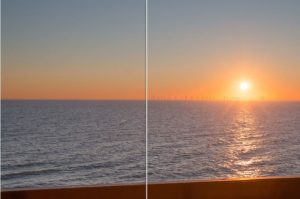
OCEAN CITY — There was some movement this month in the development of offshore wind energy farms off the coast including an announcement by one of the approved companies to move its target completion date back to the end of 2023 and the submission of the first direct testimony on turbine height.
When the PSC approved the Orsted’s Skipjack project in 2017, the approval somewhat left open the potential height of the proposed individual wind turbines as the “best technology available,” which, at the time, were the four-megawatt turbines. In the years since, technology has advanced to the point the 12-megawatt turbines are now considered the largest and most efficient available.
The target completion date for Orsted’s Skipjack project was originally set for the end of 2022, but the goal has been moved back by a year because of sluggish progress in the federal approval process.
“As the federal permitting timeline evolves, Orsted is now receiving its federal Notice of Intent for the Skipjack wind farm later than originally anticipated,” the statement reads. “As a result, Orsted has determined that moving Skipjack’s anticipated completion date from late 2022 to the new target of the end of 2023 puts us in the strongest position to deliver a successful project. Orsted remains firmly committed to working with our federal partners to complete Skipjack and provide clean, reliable offshore wind energy to 35,000 homes in the Delmarva region.”
When Orsted announced it intended to switch to the significantly larger 12-megawatt turbines for the Skipjack project, the Maryland Energy Administration (MEA) and the town of Ocean City petitioned for renewed evidentiary hearings on the original PSC approvals because the change represented a substantial departure from what was envisioned when the project was approved in 2017.
In January, the PSC held a spirited, five-hour-plus public hearing in Ocean City on the proposed change in the turbine height for the Skipjack project. In February, the PSC issued an order finding it was appropriate to hold renewed evidentiary hearings and laid out a timeline for the process. Last Friday, all parties were required to filed direct testimony and did so as required. By March 22, all parties were required to submit rebuttal testimony and the PSC’s evidentiary hearings are set for June 4-5.
Ocean City Mayor Rick Meehan on April 17 submitted direct written testimony to the PSC, reiterating the town’s concerns about the potential impact of the massive 12-megawatt turbines.
“As I have previously and repeatedly stated, Ocean City is supportive of renewable energy and the Skipjack project,” he wrote. “Ocean City supports the new jobs and economic benefit that it knows will come from the project moving forward. However, Ocean City’s concern is that if the wind turbines are built within Ocean City’s viewshed, this will have a significantly damaging effect on Ocean City’s tourism and economy. Tourism in Ocean City is the town’s lifeblood. Ocean City prides itself on its pristine views, which will no longer be pristine if the turbines are visible from shore. … The effect the larger turbines will have on property values was not considered by the Commission in 2017, but needs to be considered now. Overwhelmingly, property is purchased in Ocean City for a view of the beach, but if there are larger, more visible turbines, this will have a negative effect on property value. If the appraised value of properties decrease, this will adversely affect the tax revenue collected by Ocean City.”
Visual resource scientist and town of Ocean City consultant Robert Sullivan also submitted written testimony to the PSC last Friday. Sullivan’s testimony, based largely on years of experience and the direct findings of offshore wind energy projects in the U.S. and abroad, suggested the increased height in the turbines would almost certainly make the Skipjack project visible from the Ocean City coast.
“I am certain that on many day, the project will be easily visible from many oceanside locations in Ocean City, particularly from the northern sections of Ocean City and especially so from the upper floors of buildings in Ocean City,” he wrote. “It will sometimes be visible from the southern portions of Ocean City.”
Sullivan said the height of the turbines and their proximity to the Ocean City coast would likely make the project more visible at certain times of day.
“Regardless of viewer location, the times of greatest visibility would be early morning, when the rising sun would cause the turbines to be silhouetted against the bright morning sky, and later afternoon, when the setting sun would directly illuminate the white turbines against the darkening sky,” he wrote. “The turbines would also be more conspicuous in the afternoon when sunlit against darker clouds.”
In his written testimony, Sullivan also addressed the potential impacts of the proposed Skipjack project on Ocean City’s nighttime ocean viewshed. The turbines would include flashing red safety beacons at the top, potentially creating a line of flashing red lights across the resort’s nighttime ocean horizon.
“For viewers with clear lines of sight from Ocean City, the aerial hazard navigation lighting from the Skipjack project would be plainly visible as a short horizontal line of synchronized flashing lights obvious to onshore viewers on clear nights,” he wrote. “While the project might be less visible, or not be visible at all on foggy nights, when conditions were clear against the unlit featureless blackness of the nighttime ocean view, the project lighting would be unlikely to be missed.”
MEA Energy Program Manager Samuel Beirne submitted neutral, third-party testimony on the proposed turbine change. Beirne addressed several issues, but had this to say about the potential viewshed impacts of the 12-megawatt turbines.
“The use of the GE-Haliade 12-megawatt turbine for the Skipjack wind farm could reduce overall project visibility, as selecting this turbine could lead to a decrease in the total number of turbines to 12 or fewer,” he said. “While each turbine will be taller, the Delmarva Peninsula’s average summer weather conditions would likely further reduce visibility of the Skipjack wind farm. Weather characteristics such as humidity, air temperature and pressure, wind speed and direction, cloud cover and type and the amount of precipitation and haze may impact the visibility of the project.”
Orsted North America Mid-Atlantic Program Development Director Jens Gravaard in his written testimony pointed out the benefits of switching to the much-taller 12-megawatt turbines.
“Skipjack’s turbine selection will reduce the project’s viewshed impacts in two ways,” he wrote. “First, Skipjack’s selection of the 12-megawatt turbine reduces the number of turbines from 15 to no more than 12. Second, the Skipjack project is now expected to be located, at its closest, 22.7 miles from the Maryland coast rather than 19.5 miles as in the 8-megawatt turbine layout. This means the Skipjack project would be located over three miles further from the Maryland coast.”
Gravaard wrote by reducing the number of turbines, the impact on Ocean City’s viewshed would be reduced significantly.
“While the 12-megawatt turbine is taller than the 8-megawatt turbine used as the design basis proxy, that height difference should be evaluated in the context of the Skipjack project’s offshore location,” he wrote. “Further, with fewer turbines required to produce the ORECs approved, the Skipjack project will comprise a smaller portion of the visible horizon.”

